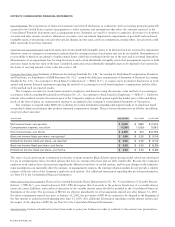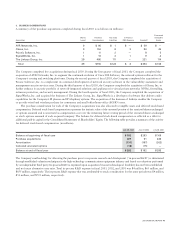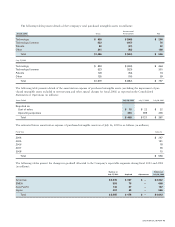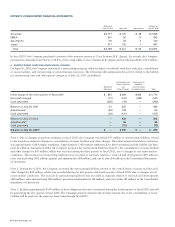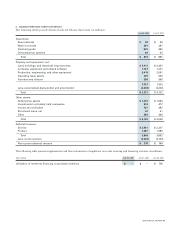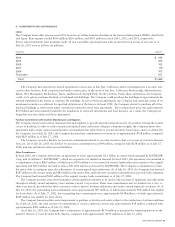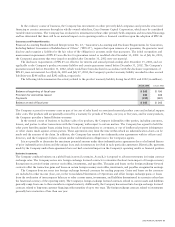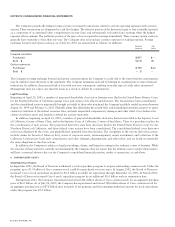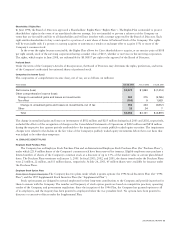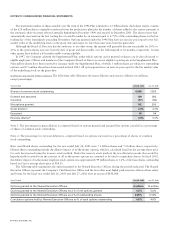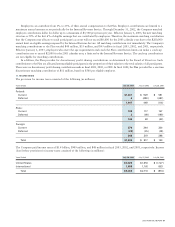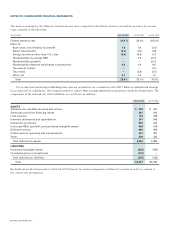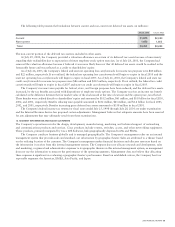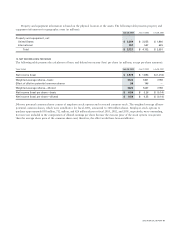Cisco 2003 Annual Report Download - page 54
Download and view the complete annual report
Please find page 54 of the 2003 Cisco annual report below. You can navigate through the pages in the report by either clicking on the pages listed below, or by using the keyword search tool below to find specific information within the annual report.
The Company periodically hedges foreign currency forecasted transactions related to certain operating expenses with currency
options. These transactions are designated as cash flow hedges. The effective portion of the derivative’s gain or loss is initially reported
as a component of accumulated other comprehensive income (loss) and subsequently reclassified into earnings when the hedged
exposure affects earnings. The ineffective portion of the gain or loss is reported in earnings immediately. These currency option contracts
generally have maturities of less than one year. The Company does not purchase currency options for trading purposes. Foreign
exchange forward and option contracts as of July 26, 2003 are summarized as follows (in millions):
Notional Fair
Amount Value
Forward contracts:
Purchased $877 $ —
Sold $ 527 $ (6)
Option contracts:
Purchased $759 $ 22
Sold $ —$ —
The Company’s foreign exchange forward and option contracts expose the Company to credit risk to the extent that the counterparties
may be unable to meet the terms of the agreement. The Company minimizes such risk by limiting its counterparties to major financial
institutions. In addition, the potential risk of loss with any one counterparty resulting from this type of credit risk is monitored.
Management does not expect any material losses as a result of default by counterparties.
Legal Proceedings
Beginning on April 20, 2001, a number of purported shareholder class action lawsuits were filed in the United States District Court
for the Northern District of California against Cisco and certain of its officers and directors. The lawsuits have been consolidated,
and the consolidated action is purportedly brought on behalf of those who purchased the Company’s publicly traded securities between
August 10, 1999 and February 6, 2001. Plaintiffs allege that defendants have made false and misleading statements, purport to assert
claims for violations of the federal securities laws, and seek unspecified compensatory damages and other relief. Cisco believes the
claims are without merit and intends to defend the actions vigorously.
In addition, beginning on April 23, 2001, a number of purported shareholder derivative lawsuits were filed in the Superior Court
of California, County of Santa Clara, and in the Superior Court of California, County of San Mateo. There is a procedure in place for
the coordination of such actions. Two purported derivative suits have also been filed in the United States District Court for the
Northern District of California, and those federal court actions have been consolidated. The consolidated federal court derivative
action was dismissed by the court, and plaintiffs have appealed from that decision. The complaints in the various derivative actions
include claims for breach of fiduciary duty, waste of corporate assets, mismanagement, unjust enrichment, and violations of the
California Corporations Code; seek compensatory and other damages, disgorgement, and other relief; and are based on essentially
the same allegations as the class actions.
In addition, the Company is subject to legal proceedings, claims, and litigation arising in the ordinary course of business. While
the outcome of these matters is currently not determinable, the Company does not expect that the ultimate costs to resolve these matters
will have a material adverse effect on the Company’s consolidated financial position, results of operations, or cash flows.
9. SHAREHOLDERS’ EQUITY
Stock Repurchase Program
In September 2001, the Board of Directors authorized a stock repurchase program to acquire outstanding common stock. Under the
program, up to $3.0 billion of Cisco common stock could be repurchased over two years. In August 2002, the Board of Directors
increased Cisco’s stock repurchase program by $5.0 billion available for repurchase through September 12, 2003. In March 2003,
the Board of Directors increased Cisco’s stock repurchase program by an additional $5.0 billion with no termination date.
During fiscal 2003, the Company repurchased and retired 424 million shares of Cisco common stock for an aggregate purchase
price of $6.0 billion. As of July 26, 2003, the Company has repurchased and retired 548 million shares of Cisco common stock for
an aggregate purchase price of $7.8 billion since inception of the program, and the remaining authorized amount for stock repurchases
under this program was $5.2 billion.
52 CISCO SYSTEMS, INC.
NOTES TO CONSOLIDATED FINANCIAL STATEMENTS


